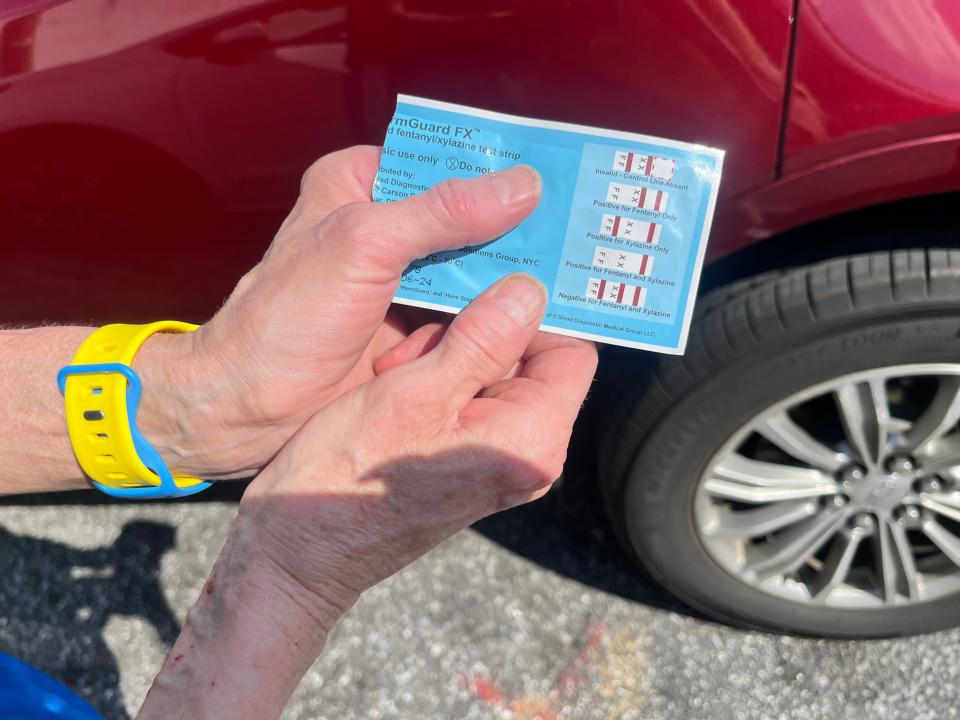'Tranq dope' is becoming more prevalent in Delaware. Can this outreach help?
Dr. Sandra Gibney stood at East Ninth and Bennett streets in Wilmington, a drug test strip in hand.
Flanked on both sides by local users, she pointed to the back of the strip’s packaging, which had five different images printed on the plastic.
“Three is key,” Gibney said, explaining how to read the test results. “If you see three lines, it means your dope is good.”
As the doctor repeated herself, the man and woman by her side stared intently at the packaging, the gears in their heads slowly turning as they tried to make sense of it.

The test – which detects both fentanyl and xylazine, an animal tranquilizer that’s increasingly being cut into fentanyl and that can cause death and necrotic wounds on a user’s body – is counterintuitive.
While most rapid strips used for pregnancy or coronavirus are positive if they have multiple lines, this is the opposite. A red control line, a line above the fentanyl marking and a line above the xylazine marking means a user’s drug is negative for fentanyl and xylazine.
XYLAZINE WOUNDS: The race to treat wounds caused by 'tranq dope' in Delaware before amputation is needed
If there is no line above one or both of the drug makings, it means the strip has detected the presence of fentanyl and/or xylazine.
As Gibney remained on the street corner, patiently reiterating how to read the test, a glimmer of understanding flashed across the man’s face.
“No lines, leave it the (expletive) alone,” he said, garnering a laugh from those around him.
“Sorry,” he added a moment later. “I didn’t mean to be so gross, but I had to keep it simple for my brain.”
In part, this exchange is why Gibney, Lt. Gov. Bethany Hall-Long and volunteers with Brandywine Counseling & Community Services walked the streets of Wilmington on a recent Monday evening, handing out bags of food and toiletries, the opioid-reversing naloxone and the new test strips.
BACKGROUND: 'Tranq dope' is killing Delawareans. The state hopes these tests will help curb overdoses
Created by Bear-based SIVAD Diagnostic Medical Group LLC, the dual tests are the first of their kind nationally. While rapid fentanyl tests have been around for years – and more recently, companies have begun producing rapid xylazine tests – there has never previously been a single test that can detect both drugs.

With overdoses often spiking around holidays, the volunteers wanted to begin handing out supplies in hopes of making users more aware of what’s in their drugs – if for nothing else than to simply improve education about xylazine.
“Will they not take a drug because it has it in it? No,” Gibney said. “But I think eventually, if enough people are aware and enough people get these xylazine wounds, there may be some pressure to do something.”
‘Chop their limbs off’
Though xylazine is not a new drug – it’s been used by veterinarians for decades to sedate large animals such as horses, cattle and non-domesticated animals – it was only relatively recently that users in Delaware began to report the drug in the state’s fentanyl supply.
Those who work in addiction medicine knew it was coming, given users in Philadelphia’s Kensington neighborhood began seeing it on a more widespread scale in 2018. While xylazine first appeared in Kensington in the mid-2000s, it didn’t become prevalent until about a decade later.
Addiction specialists have long said anything that hits Kensington ultimately makes its way to northern Delaware. That was the case when fentanyl became an additive to heroin, and then when fentanyl slowly overtook that opioid as users’ drug of choice.
ADDICTION IN DELAWARE: Her son died after being kicked out of a Florida sober home. How Delaware may prevent that
As Gibney and the volunteers made their way through Wilmington, it was clear that city residents who struggle with addiction know of xylazine’s effects.

“People out here be trippin’ off that dope,” one man said as the volunteer group handed him supplies and explained why they were on the city’s East Side. Xylazine often causes users to go into stupors or a trancelike state, which can make them vulnerable to robbery and assault.
“That’s what’s killing people,” another man said.
“Yeah, and what’s causing them to have to chop their limbs off,” Gibney replied.
Though xylazine can be deadly – too much can cause dangerously low blood pressure, slow breathing and low heart rate, leading to death – it also often causes wounds that become infected and necrotic, resulting in the amputation of limbs and digits.
The way the drug kills skin and muscle, Gibney said, is by deoxygenating the tissue it comes in contact with. A “very acidic” substance, xylazine comes in powder form, meaning it’s typically only snorted or injected.
READ: They were parents, friends and colleagues. This gallery shows them beyond their addiction
If injected into a vein, the vein can collapse. But, Gibney said, users often miss, which causes the xylazine to then travel under a person’s skin, killing the tissue as it goes.
If snorted, xylazine can completely obliterate a person’s septum – the part of the nose that separates the two nasal chambers. Recently, Gibney even had a patient at her weekly wound care clinic whose nose was completely eroded by the drug.
“Her nose just fell off because it was completely necrotic,” Gibney said. “And the other girl's just looked like a blow-hole.”

Aside from the cosmetic issues brought about by snorting the drug, Gibney said, xylazine can cause the blood-brain barrier membranes to explode, which means there’s nothing blocking harmful substances from reaching the brain.
This can then lead to encephalitis or inflammation of the brain tissue. The inflammation causes the brain to swell, which can lead to seizures and death.
Because there’s currently no reversal approved for use in humans, educating users about the drug and how to reduce harm – such as by testing their drugs – is currently the best tool addiction specialists have.
Still, it’s not a particularly good option.
“The bottom line is, until we have a reversal agent, there's no way that we can fix this,” Gibney said.
Got a tip? Send to Isabel Hughes at ihughes@delawareonline.com or 302-324-2785. For all things breaking news, follow her on Twitter at @izzihughes_
This article originally appeared on Delaware News Journal: Delaware addiction outreach turns focus to xylazine, fentanyl testing

